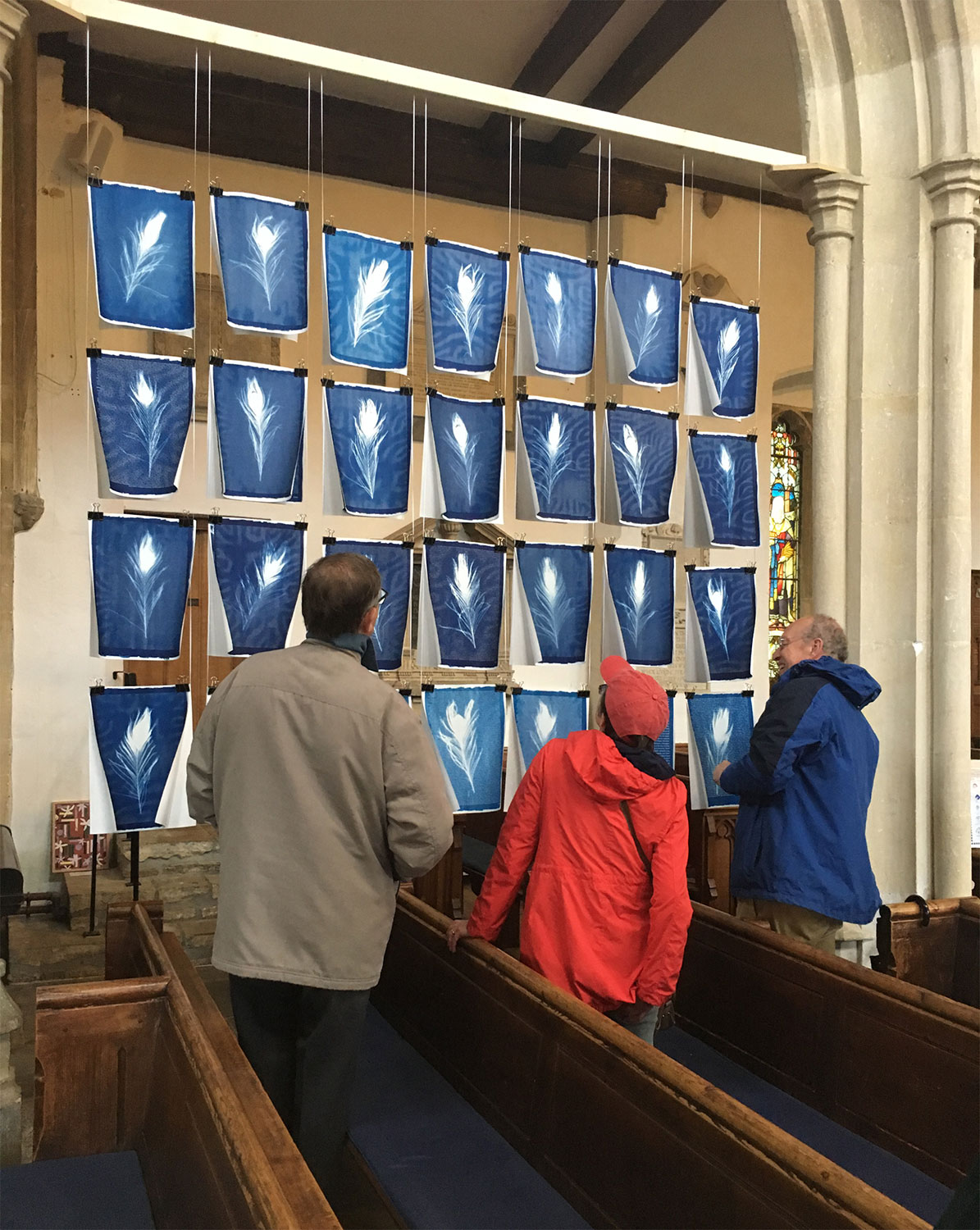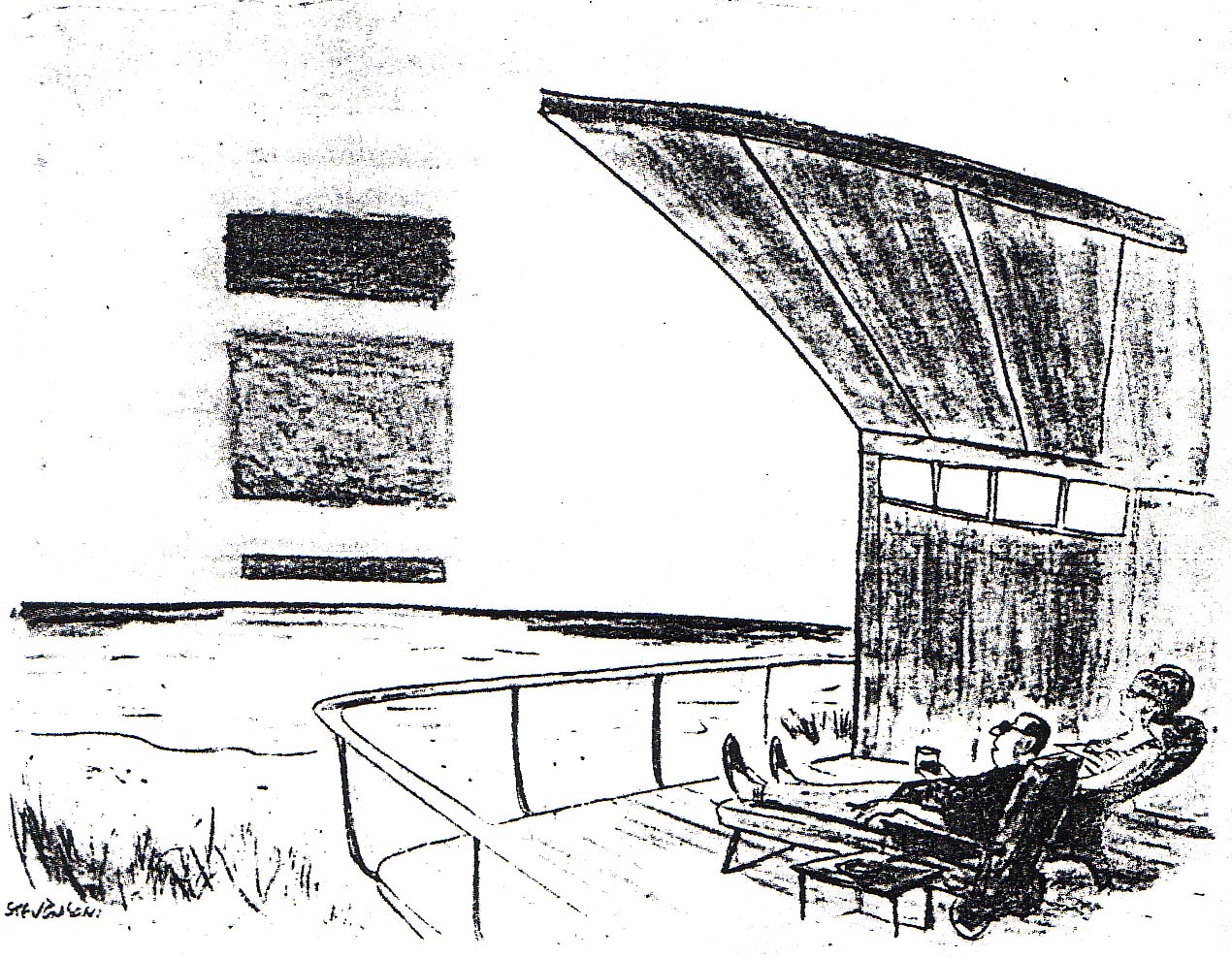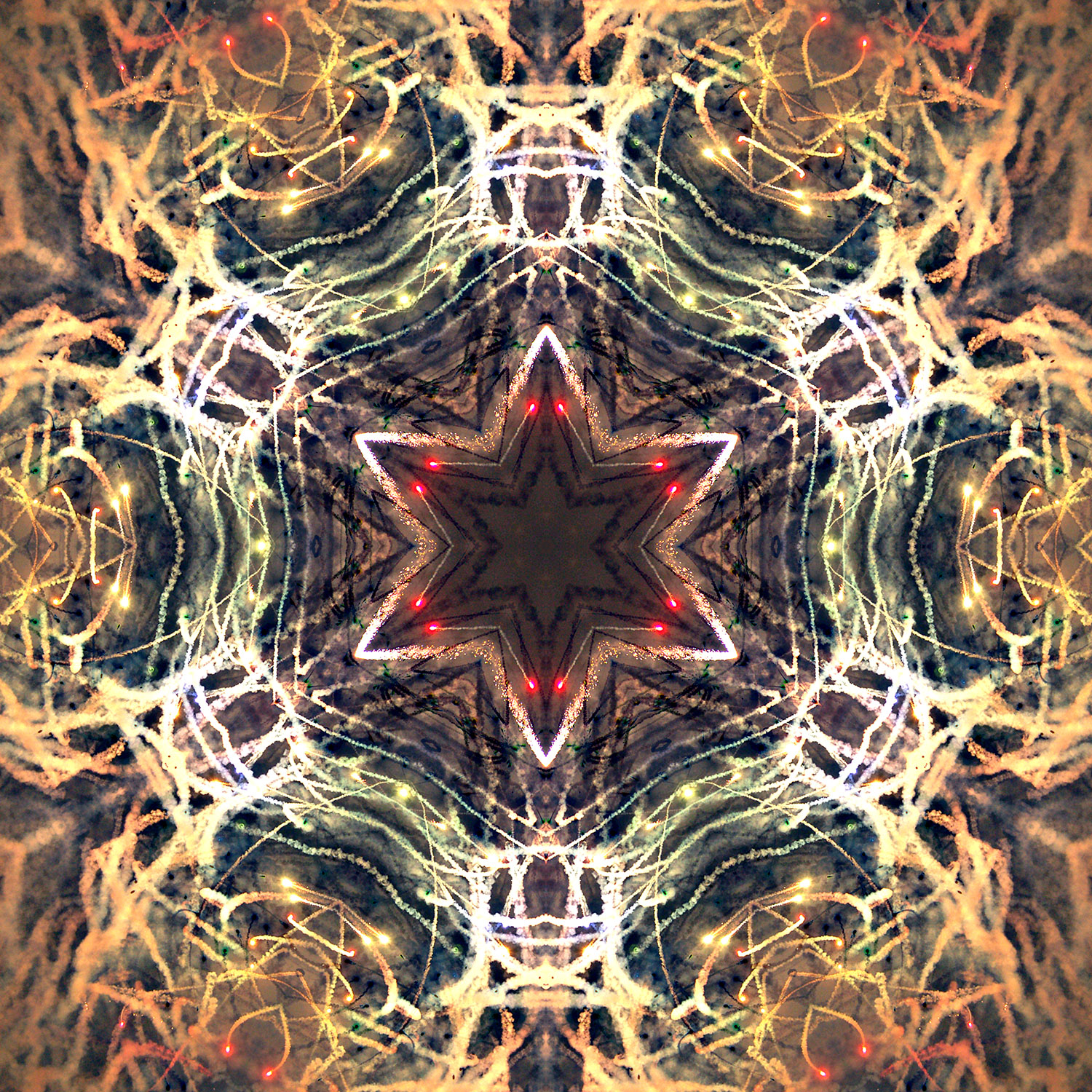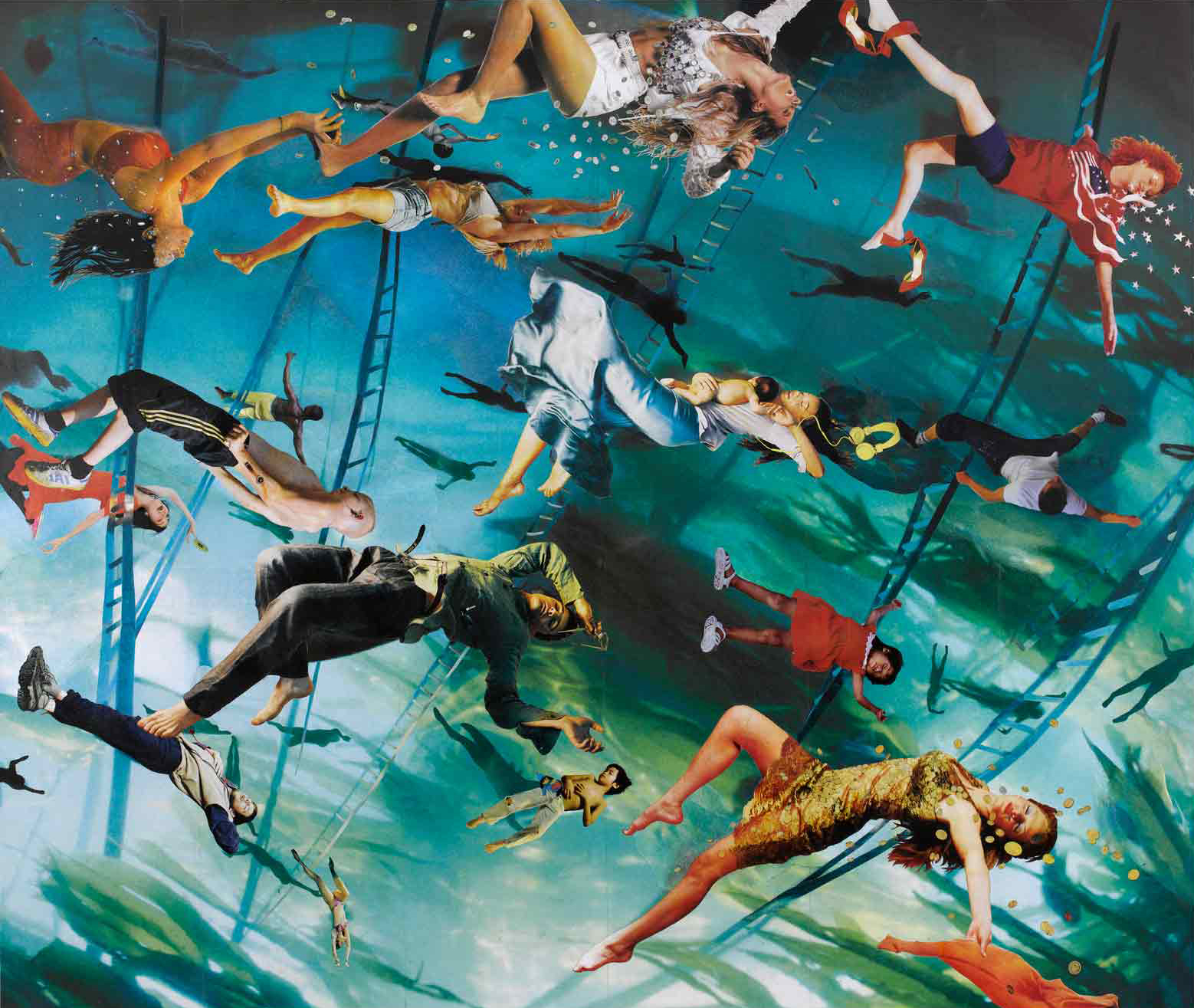NOTEBOOK SPOTLIGHT: Scriptorium
The text below is adapted from publication in ‘Photography as the Bible’s New Illumination’, in Transforming Christian Thought in the Visual Arts: Theology, Aesthetics, and Practice (Routledge, 2021), pp.55-58; and also from VT Issue 1, pp.16-17.
Scriptorium consists of sixty-five pages of unbound biblical text, printed white on blue with the cyanotype process. Discovered in 1842 by Sir John Herschel, the cyanotype was an early photographic process concerned with facsimile reproduction: the images are made when, by a process of masking, iron compounds in the sensitised paper variously react to light, resulting in an inverted duotone image after developing. The cyanotype lends itself to close transcription through contact printing and clear tonal differentiation, whether with technical drawings – from which we get the term ‘blueprint’ – or with outlines and textures of natural forms, as in Anna Atkin’s Photographs of British Algae, first appearing in 1843.
Each of Scriptorium’s pages was created with two masks laid one on top of the other and exposed over the sensitised paper in the sunlight for a few minutes: an acetate sheet printed with the complete text of a biblical book, and a peacock feather. With such a layering process, I found that copying or picturing the Bible offers a very particular key to its reading and interpretation. A scriptorium is a place where manuscripts were once copied by monks and as such describes the moment when a text is unbound, and where the primal structure of ‘Bible’ as linear and fixed does not yet exist. The idea of the scriptorium frames the moment before the binding of its pages: biblical knowledge is being regenerated, drawn together and disseminated, materially embodied, and refigured in the event of making.
In contemporary terms, the online availability of multiple English, international and original language Bibles heralds a new era for Bible use which in some ways mirrors the process of monastic reproduction.[1] For public domain text, the moment when a computer’s ‘script’ runs its programme for the display of content is what enables the Project Gutenberg text of the Bible (King James Version) to form and reform at the tap of a screen. Biblical books that notionally approximate to single documents[2] then become interchangeable, fluid elements (literally html ‘elements’) whose placing by the script could take any number of forms. Such a state of potentiality is figured anew each time Scriptorium is displayed. Each variation of order, overlay, facingness, three-dimensionality, or visibility of the books performs or enacts a loosening of their presumed fixity. Unframed, rolled, or folded, they remain inherently unstable.
The text itself is treated as a <body> element without verse or line breaks, with simple tagging for either right-aligned text (Old Testament) or left-aligned text (New Testament), and a footer section with abbreviated title. Within the decided format and limit of page size (folio), some text is severely reduced in size with longer books such as Isaiah and Jeremiah. The format has a blocking effect and emphasises the surface as a visual field, perhaps a screen. With computer technology, the blue screen has the negative connotation of a fatal system error, from which a resurrection has to emerge between black (being switched off) and white (with the text’s instruction). Here the peacock feathers are an interruption, a glitch, their whiteness bleaching the text. Their register is of something intuited, both symbolic and graphic, in the moment of the text’s blanking.[3] They flicker, or flow, like the evidence of hand or spirit in the making of something without a camera but with light’s revelation and shadow’s inversion.
The Bible as I picture it in Scriptorium is an attempt to situate its texts in the unbounded state of illumination. As documents from the eyes and hands of witnesses, the texts were, in the past, codified by the processes of writing and binding. But seen as untied documents of literal illumination, a view on something less static may be glimpsed. A visual theology of the open text, the work invites the reader-viewer to look discursively with, or alongside, photography, rather than through it. To practice looking in this way is, I think, to court the same kind of openness that the Bible itself does – a book whose real world connections open onto and into fluid and relational encounter, rather than monologic iteration: the Bible and photography become verbs rather than nouns.
[1] See http://www.biblegateway.com.
[2] Though this is of course far from the stable designation implied, as challenged by various documentary hypotheses in the Victorian era. Slightly aside from the question of origin here, I take biblical document to mean the rendering of the designated author’s intent to document something as writing. Most resistent to this document-as-writing is the book of Psalms, strictly speaking a collection of songs or prayers. To that end, the Psalms are excluded from Scriptorium, though I now am venturing into a different project of their illumination with The Bright Fields.
[3] Another example of biblical ‘blanking’ is found in Adam Broomberg and Oliver Chanarin’s Holy Bible (2013), in which they superimpose a printing of the KJV text with photographs from the Archive of Modern Conflict. In the final pages of Revelation, a burnt out film strip exposes whiteness across the text which I have discussed elsewhere as a de-centred and deconstructive theology of God beyond words, God as rupture. See Sheona Beaumont, ‘Engaging with the Bible in Visual Culture: Hermeneutics between Word and Image, with Broomberg and Chanarin’s Holy Bible’, Religion and the Arts, 23:4, pp.411-433; and Sheona Beaumont, Scaping Sin: Leviticus 15-18, The Visual Commentary on Scripture, 2019, online at www.thevcs.org.
Header image: Scriptorium, 2018 (installation view at St Cyriac’s Church, Lacock), by Sheona Beaumont; 65 cyanotype prints.
EXCURSUS:
run-script <command>
Set-Location $bible
def read_text(fname):
beg_e = re.compile(r”\*\*\* ?start of (this|the) project gutenberg ebook[^*]*\*\*\*”)
txt = open(“KJV” + fname).read().lower()
print(“Gen”+”Ex”+”Lev”+”Num”+”Deut”+”Josh”+”Judg”+”Ruth”+”1Sam”+”2Sam”+”1Kings”+”2Kings”+”1Chr”+”2Chr”+”Ezra”+”Neh”+”Esth”+”Job”+”Prov”+”Eccl”+”Song”+”Isa”+”Jer”+”Lam”+”Ezek”+”Dan”+”Hos”+”Joel”+”Am”+”Ob”+”Jon”+”Mic”+”Nah”+”Hab”+”Zeph”+”Hag”+”Zech”+”Mal”+”Mt”+”Mk”+”Lk”+”Jn”+”Acts”+”Rom”+”1Cor”+”2Cor”+”Gal”+”Eph”+”Phil”+”Col”+”1Thess”+”2Thess”+”1Tim”+”2Tim”+”Titus”+”Philem”+”Heb”+”Jas”+”1Pet”+”2Pet”+”1Jn”+”2Jn”+”3Jn”+”Jude”+”Rev”)
book = open(“kjv.txt”, “r”)
“scripts”: {“spirit”: “node_modules/.bin/tap test/\*.js”
.echo The first argument is ${$arg1}.
scroll noun (1) \ skrəʊl \
1 : a roll of parchment or paper for writing on.
2 : the facility which moves a display on a computer screen in order to view new material.
script noun (3) \ˈskript \
1a : something written : TEXT.
b : an original or principal instrument or document.
2 : the written text of a stage play, screenplay, or broadcast specifically : the one used in production or performance.
3 : a plan of action ; an automated series of instructions carried out in a specific order.
blueprint noun (2)
1 : a photographic print in white on a bright blue ground or blue on a white ground used especially for copying maps, mechanical drawings, and architects’ plans. Originally cyanotypes (ammonium iron citrate + potassium ferricyanide).
2 : something resembling a blueprint (as in serving as a model or providing guidance)
especially : a detailed plan or program of action.



